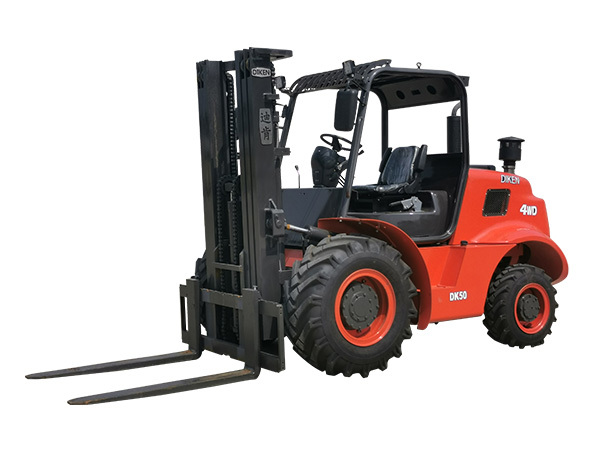Diken news
A Comprehensive Guide to Operating Rough Terrain Forklifts Safely
Release time: 2025-07-16
A Comprehensive Guide to Operating Rough Terrain Forklifts Safely
Table of Contents
- 1. Understanding Rough Terrain Forklifts
- 2. The Importance of Safety in Forklift Operation
- 3. Pre-Operation Safety Checks
- 4. Operating Techniques for Rough Terrain Forklifts
- 5. Navigating Challenging Environments Safely
- 6. Maintenance and Inspections
- 7. Training and Certification Requirements
- 8. Common Mistakes to Avoid When Operating Rough Terrain Forklifts
- 9. Frequently Asked Questions
- 10. Conclusion
1. Understanding Rough Terrain Forklifts
Rough terrain forklifts are specialized material handling machines designed for outdoor conditions, particularly in construction and agricultural settings. These forklifts are equipped with larger tires and enhanced suspension systems, allowing them to traverse uneven surfaces, mud, gravel, and other challenging terrains. With lifting capabilities often reaching heights of over 20 feet, they play a crucial role in effectively transporting materials in rugged environments. Understanding the unique features and functionalities of these machines is essential for safe operation.
2. The Importance of Safety in Forklift Operation
Operating a rough terrain forklift safely is paramount to minimize accidents and injuries. The dynamics of rough terrain operation differ significantly from standard forklifts, which can lead to potential hazards if not properly managed. The Occupational Safety and Health Administration (OSHA) emphasizes the importance of adhering to safety regulations to protect both operators and surrounding personnel. Implementing safety measures not only mitigates risks but also enhances overall efficiency and productivity on the job site.
Understanding the Risks Involved
The nature of rough terrain presents unique challenges, including:
- **Instability:** Uneven ground can lead to tipping or losing control.
- **Visibility Issues:** Operating in areas with obstacles may hinder visibility.
- **Load Management:** Improper load handling can result in accidents or equipment damage.
3. Pre-Operation Safety Checks
Before operating a rough terrain forklift, conducting thorough pre-operation safety checks is critical. These checks ensure that the machine is in optimal working condition and identify any potential issues that could lead to dangerous situations. Following a comprehensive checklist can significantly reduce the likelihood of accidents.
Essential Pre-Operation Checks
1. **Visual Inspection:** Check for visible signs of wear and tear, leaks, or damages to the frame and tires.
2. **Fluid Levels:** Ensure that fuel, oil, hydraulic fluid, and coolant levels are within acceptable ranges.
3. **Controls and Features:** Test all controls, including brakes, steering, and lifting mechanisms, to ensure they function properly.
4. **Safety Equipment:** Verify that all safety equipment, such as seat belts and fire extinguishers, are present and operational.
4. Operating Techniques for Rough Terrain Forklifts
Mastering the operation of rough terrain forklifts involves understanding specific techniques tailored to their design and intended use. Operators should prioritize safety and efficiency throughout their tasks.
Key Operating Techniques
- **Proper Loading:** Always ensure that the load is balanced and within the forklift's rated capacity. Load the heaviest items as low as possible to lower the center of gravity.
- **Safe Driving Practices:** Drive at a controlled speed, particularly when approaching inclines or declines. Use caution when navigating around obstacles.
- **Utilize the Forks Effectively:** Position the forks at the correct height when lifting and traveling. Avoid making sharp turns, especially while loaded.
- **Maintain a Safe Distance:** Keep a safe distance from pedestrians and other machinery to prevent accidents.
5. Navigating Challenging Environments Safely
Operating rough terrain forklifts often involves dealing with various environmental challenges. Understanding how to navigate these situations safely is essential for any operator.
Strategies for Safe Navigation
- **Assess the Terrain:** Before moving, evaluate the ground conditions and identify potential hazards such as ditches, rocks, or soft soil.
- **Adjusting for Slopes:** When operating on slopes, drive uphill in a straight line with the load uphill. Use a lower gear on descents to maintain control.
- **Dealing with Mud and Wet Conditions:** In wet conditions, slow down and avoid sudden movements to prevent slipping. If necessary, utilize mats or planks to create a stable path.
6. Maintenance and Inspections
Regular maintenance is crucial for ensuring the longevity and safe operation of rough terrain forklifts. A well-maintained machine significantly reduces the risk of mechanical failures that could lead to accidents.
Key Maintenance Practices
- **Scheduled Inspections:** Follow a routine inspection schedule to check all major components, including tires, brakes, and hydraulic systems.
- **Cleaning and Lubrication:** Regularly clean the forklift and lubricate moving parts to prevent wear and ensure smooth operation.
- **Professional Servicing:** Engage certified technicians for extensive repairs and servicing to maintain safety and compliance with regulations.
7. Training and Certification Requirements
Proper training is essential for all operators of rough terrain forklifts. Not only does this ensure safety, but it also helps in complying with legal requirements.
Essential Training Components
- **Classroom Training:** Covers the theoretical aspects of forklift operation, including safety regulations and load management.
- **Practical Training:** Hands-on training allows operators to familiarize themselves with the machinery under the supervision of experienced trainers.
- **Certification:** Upon completion of training, operators should obtain certification to legally operate rough terrain forklifts.
8. Common Mistakes to Avoid When Operating Rough Terrain Forklifts
Even experienced operators can fall prey to common mistakes that jeopardize safety. Awareness of these pitfalls is essential for safe operations.
Frequent Mistakes Include
- **Ignoring Safety Protocols:** Neglecting to follow safety procedures can lead to serious accidents.
- **Overloading the Forklift:** Exceeding the weight limit can result in tipping and equipment damage.
- **Neglecting to Communicate:** Not signaling intentions to nearby workers can create hazardous situations.
9. Frequently Asked Questions
What are the advantages of using rough terrain forklifts?
Rough terrain forklifts are designed to handle challenging outdoor environments, making them ideal for construction and agricultural sites. Their ability to traverse uneven surfaces and carry heavy loads efficiently is a significant advantage.
How do I know if I need a rough terrain forklift?
If your operations involve lifting and transporting materials over uneven ground, wet conditions, or in outdoor environments, a rough terrain forklift is necessary.
What safety gear should operators wear?
Operators should wear appropriate personal protective equipment (PPE), including hard hats, steel-toed boots, gloves, and high-visibility vests.
Can anyone operate a rough terrain forklift?
No, operators must be trained and certified to operate rough terrain forklifts in compliance with OSHA regulations.
How often should rough terrain forklifts be inspected?
Regular inspections should be conducted before each shift, with more detailed checks and maintenance scheduled according to the manufacturer's recommendations.
10. Conclusion
Operating rough terrain forklifts safely is a multifaceted responsibility that requires knowledge, skills, and adherence to safety protocols. By understanding the machine's capabilities, conducting thorough pre-operation checks, and continuously enhancing your operational techniques, you can ensure a safe and efficient working environment. Remember, safety is not just a compliance issue; it’s a commitment to yourself and your coworkers. By implementing the best practices outlined in this guide, you’ll be well on your way to becoming an accomplished and safe rough terrain forklift operator.
Keywords: rough terrain forklift










